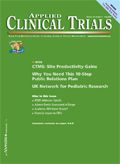Integrated START for Studies
Applied Clinical Trials
Parexel's Start-up and Accelerated Recruitment Team (START) is applying an integrated approach to data that is to be applied in early phases to alleviate recruitment and study start-up challenges.
In 2007, prior to that year's DIA meeting, Parexel announced its Start-up and Accelerated Recruitment Team (START). Now, two years later, the Team has added to its base of experts, as well as its accomplishments. In an interview with Applied Clinical Trials, Lars-Olof Eriksson, PhD, MSc, recently announced vice president of START, discussed the three-prong integrated approach of START and its influence on clinical trial decisions.
Eriksson most recently was senior director in Clinical Research Operations specializing in patient recruitment at Merck. Of the START group, he says, "What we have are really clear strategies that were expressed by leadership at Parexel to take a strategic focus on planning and execution of clinical trials and put the right resources in place and apply a more data-driven approach to help sponsors accelerate study initiation and achieve Last Patient In—LPI—milestones."
Three part START
To that end, within START, there are three groups that now report to Eriksson. These are the Feasibility and Clinical Informatics; Study Start-Up and the Patient Recruitment Planning groups. Each group applies both internal and external tools and databases to its specific clinical trial function and works closely in parallel and in concert to deliver knowledge to the client, as well as develop milestone timelines.
With a focus on helping sponsors overcome the financial costs associated with both subject recruitment and site start-up delays, START is applying data in an integrated approach earlier in the phase process.
For example, the feasibility group can apply data mining techniques to both internal resources on investigators (past performance), and external databases (clinicaltrials.gov, as one example), and previous protocol comparison to clinically and medically determine feasibility. From there, specific determinations can be made on the protocol design. "For example, with one diabetes study, we had the possibility of identifying 30,000 to 50,000 patients. After the availability of patients and the cumulative effect of enrollment were modeled, we had 28,000 patients. Weighing this information against the actual protocol, there were nine patients left," said Eriksson. "Our focus is to create more awareness with the client of this type of feasibility assessment, and to discuss potentially opening up the protocol more, for instance, while still fitting the study requirements."
From there, the Team then can model and forecast its study timelines for sponsors that are reliable.
The Start-Up unit uses a propriety calculator (Scenario Planning and Recruitment Calculator or SPARC) to take all the data and apply it in the calculator's algorithms to activate the sites. "The sites can be categorized as simple, or complex, usually based on the regulatory requirements of each. Complex sites usually are the larger academic institutions," explained Eriksson.
The Patient Recruitment Planning group uses Parexel patient recruitment specialists to develop the outreach plan.
During the typical two- to six-month period where sponsors are awaiting regulatory approval, the CRO is actively working on the site and recruitment activities. So, for example, the sites are being qualified, but more than that, the specialists are actively pre-identifying the patients that would be eligible for that study. "We can see if each site that has been chosen has enough to deliver on the study according to plan, or if we need to launch back up sites," explained Eriksson.
The specialists also explore patient records for insight into reading habits, interests, etc., that would help guide the recruitment plan. "It helps to communicate more effectively to the patient, if she is a 50-year-old post-menopausal woman or a 20 year-old college student," said Eriksson. "How do we appeal and respond to those individuals in outreach."
For Eriksson, who has a 30-year history of experience in patient recruitment, site implementation, project management, and global drug development, his passion for the Parexel approach is evident. "It is a unique program out there in regard to both sponsors and CROs."
Eriksson believes this aspect of the industry holds unique challenges. Specifically in regard to EMRs, patient registries, and the like, which have promised integration via the Obama administration. "The information is out there that we can use, but the challenge is to mine that data in a legal and ethical way," emphasizes Eriksson. —Lisa Henderson

Improving Relationships and Diversifying the Site Selection Process
April 17th 2025In this episode of the Applied Clinical Trials Podcast, Liz Beatty, co-founder and chief strategy officer, Inato, discusses a number of topics around site engagement including community-based sites, the role of technology in improving site/sponsor relationships, how increased operational costs are impacting the industry, and more.
Behind the Buzz: Why Clinical Research Leaders Flock to SCOPE Summit
February 7th 2025In this episode, we meet with Micah Lieberman, Executive Conference Director for SCOPE Summit (Summit for Clinical Ops Executives) at Cambridge Innovation Institute. We will dive deep into the critical role of collaboration within the clinical research ecosystem. How do we bring together diverse stakeholders—sponsors, CROs, clinical trial tech innovators, suppliers, patients, sites, advocacy organizations, investors, and non-profits—to share best practices in trial design, program planning, innovation, and clinical operations? We’ll explore why it’s vital for thought leaders to step beyond their own organizations and learn from others, exchanging ideas that drive advancements in clinical research. Additionally, we’ll discuss the pivotal role of scientific conferences like SCOPE Summit in fostering these essential connections and collaborations, helping shape the future of clinical trials. Join us as we uncover how collective wisdom and cross-industry partnerships are transforming the landscape of clinical research.